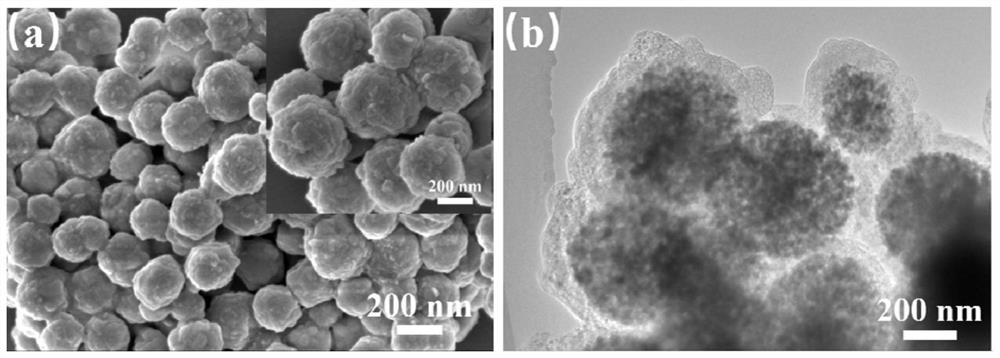Synthesis method and application of mixed valence manganese-based oxide composite material
A technology of manganese-based oxides and composite materials, which is applied in the field of high-rate charging and discharging, can solve problems such as unfavorable battery rate performance, and achieve the effects of promoting electrochemical performance, improving the first Coulombic efficiency, and being environmentally friendly
- Summary
- Abstract
- Description
- Claims
- Application Information
AI Technical Summary
Problems solved by technology
Method used
Image
Examples
Embodiment 1
[0040] (1) Dissolve 1 mmol of manganese acetate and 10 mmol of ammonium bicarbonate into 30 mL of ethylene glycol solution, stir evenly, transfer to a 50 mL reactor, and react with solvothermal reaction at 180 °C for 12 h; After cooling, centrifuge washing and drying to obtain a white powdery manganese carbonate micro-nanosphere precursor;
[0041] (2) Dissolve 50 mg of manganese carbonate precursor and 100 mg of dopamine hydrochloride in Tris buffer solution with pH = 8.5, carry out self-polymerization reaction at room temperature, then centrifuge, wash and dry the black product to obtain manganese carbonate / polymer Dopamine intermediate;
[0042](3) The intermediate was placed in a tube furnace and annealed under the protection of a nitrogen atmosphere. The temperature was first raised to 700°C for 5 hours, and then cooled to 500°C for 2 hours to obtain carbon-coated, first-class nanoparticles. Composed of secondary porous nano-MnO (MnO@NC) composites with 3D structure;
...
Embodiment 2
[0049] (1) Dissolve 1 mmol of manganese acetate and 5 mmol of ammonium bicarbonate in 30 mL of ethylene glycol solution, stir evenly, transfer to a 50 mL reaction kettle, and react with solvothermal reaction at 150 °C for 12 h; After cooling, centrifugal washing, and drying, the manganese carbonate microsphere precursor of white powder is obtained;
[0050] (2) Dissolve 100 mg of manganese carbonate precursor and 50 mg of dopamine hydrochloride in a Tris buffer solution with pH=8.5, carry out self-polymerization reaction at room temperature, then centrifuge the black product, wash and dry to obtain manganese carbonate / polydopamine Intermediate;
[0051] (3) Place the intermediate in a tube furnace and anneal it under the protection of a nitrogen atmosphere. The temperature is first raised to 500°C and kept for 7 hours to obtain a secondary porous layer with a 3D structure that is coated with a carbon layer and composed of primary nanoparticles. Nano-MnO (MnO@NC) composite mat...
Embodiment 3
[0054] (1) Dissolve 1 mmol of manganese acetate and 8 mmol of ammonium bicarbonate in 30 mL of ethylene glycol solution, stir evenly, transfer to a 50 mL reaction kettle, and react with solvothermal reaction at 180 °C for 10 h; After cooling, centrifugal washing, and drying, the manganese carbonate microsphere precursor of white powder is obtained;
[0055] (2) Dissolve 100 mg of manganese carbonate precursor and 100 mg of dopamine hydrochloride in a Tris buffer solution with pH=8.5, carry out self-polymerization reaction at room temperature, then centrifuge the black product, wash and dry to obtain manganese carbonate / polydopamine Intermediate;
[0056] (3) The intermediate was placed in a tube furnace and annealed under the protection of a nitrogen atmosphere. The temperature was first raised to 600°C for 5 hours, and then cooled to 500°C for 2 hours to obtain carbon-coated, first-class nanoparticles. Composed of secondary porous nano-MnO (MnO@NC) composites with 3D structu...
PUM
| Property | Measurement | Unit |
|---|---|---|
| Particle size | aaaaa | aaaaa |
Abstract
Description
Claims
Application Information
 Login to View More
Login to View More - R&D
- Intellectual Property
- Life Sciences
- Materials
- Tech Scout
- Unparalleled Data Quality
- Higher Quality Content
- 60% Fewer Hallucinations
Browse by: Latest US Patents, China's latest patents, Technical Efficacy Thesaurus, Application Domain, Technology Topic, Popular Technical Reports.
© 2025 PatSnap. All rights reserved.Legal|Privacy policy|Modern Slavery Act Transparency Statement|Sitemap|About US| Contact US: help@patsnap.com



